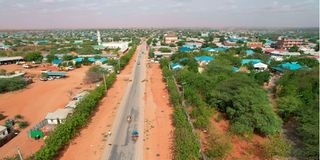Trees on roadsides a good means to attaining 5bn tree target

An aerial view of Mandera town.
It is said that forests are the basis of a nation’s wealth, and justifiably so. The therapeutic nature of greenery and its adornment oozes good health. Trees, in their many families, have socio-cultural, economic and environmental prominence.
Socially, trees are sources of food, medicine, shade, shelter, clothing, ornaments and leisure. Culturally, some have religious significance. Some are worship places while others speak of and to life (sacred trees). Economically, they provide wood fuel, industrial raw materials, construction material, and merchandise for trade; create employment for waste management companies and highway groundsmen and landscapers besides boosting tourism.
Environmentally, trees are atypical environmental conservators. They protect each other, proffer food for animals, humify the soil, hold soil together, sink carbon-dioxide, manufacture oxygen and freshen the air. Forests affect the hydrologic cycle, contributing a lot of gaseous water into the atmosphere.
Biological wealth
Trees, or forests, are a nation’s precious biological wealth and Kenya is aphetically alive to this. President William Ruto’s plan to plant five billion trees in five years is, therefore, noble and timely. It will assuredly counter the animus towards forests, especially the natural ones. A biting concern, however, is the unavailability of land for afforestation.
Consequently, Dagoretti South MP John Waweru Kiarie’s motion, moved in the National Assembly last November 16, is the way to go. It seeks to have trees planted on roadsides and road reserves as a means of attaining the five billion trees vision.
The government targets to complete all roads under construction, upgrade rural access roads and construct new roads, including in informal settlements. This is a bundle of road action and environmental concerns must be addressed.
First, an environmental/social impact assessment (ESIA) should be done for all the projects to investigate the amount of injury of the road works and suggest mitigation measures. Secondly, make an inventory of trees at risk of being felled—according to type, probable age, monetary and social value. That will help in protecting trees that are rare and hugely significant—as a show of environmental hubris.
The ESIA report should also particularise the kind of trees that should be planted on every road, according to region, climate and environmental interactions. If possible, fruit trees should be planted, also for food and nutrition for, especially, the homeless and random hungry. In fact, schools and public spaces should have many fruit trees as part of their flora.
Roadside afforestation
Roadside afforestation is more plausible along highways, inter- and intra-county and urban roads, which have more reserve land and need beautification. It will enhance scenic beauty, protect road shoulders against erosion and mass wasting, supply fruits to road users and create a wildlife habitat.
As the MP succinctly put it, require contractors to carry out afforestation and reforestation of roadsides and road reserves. Their contracts should detail the tree planting expected of them, checked off during project handover. Forest reserves must also operate under full tree capacity, hence afforestation.
Silviculture should also be encouraged as a high-priority agricultural venture through the installation of carbon credits. Additionally, landowners should continually be spurred on to create wood lots, live hedges and personal arboreta through a variety of personalised government exchange.
That way, Kenya will not only attain 10 per cent forest cover but will climb out of climate change disasters and earn through international carbon trading.
Dr Kipkiror, PhD, environmental consultant, is a lead expert in environmental and social impact assessment. [email protected].





